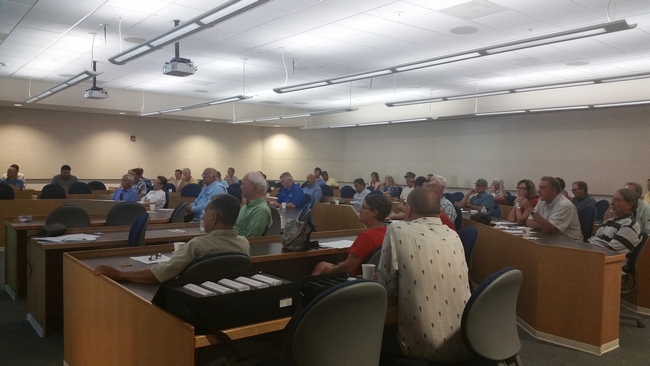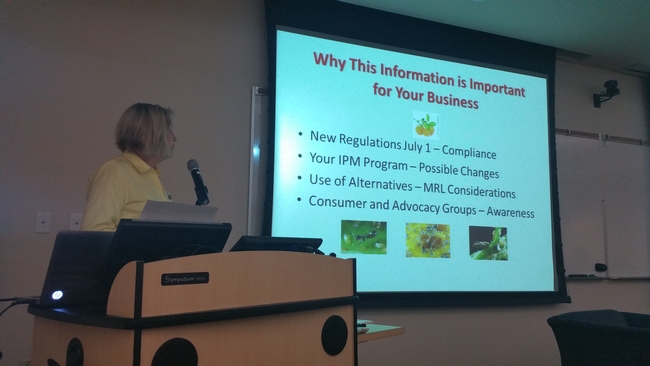
Posts Tagged: Diaphorencyrtus
Annual Citrus Grower Seminar in Southern California: A Review
The Citrus Research Board in conjunction with the University of California Cooperative Extension (UCCE) held their annual grower seminar on Tuesday, June 30, 2015 at the University of California, Riverside (UCR) Palm Desert Center. Seminars also took place in Santa Paula, CA on June 25th and in Exeter, CA on July 1st. Speakers from all over the state from different agencies shared their knowledge and expertise with the group.
Mark Hoddle, a Biological Control Specialist at UCR gave an update of the biological control of Asian citrus psyllid (ACP). The ACP's natural enemy, Tamarixia radiata has been successful since its release in Southern California in 2011. The Tamarixia kills the ACP nymphs either by parasitizing them (i.e., females eggs laid underneath ACP nymphs and the parasitoid larvae burrow into the nymph to feed which kills the pest) or by host feeding (i.e., female parasitoids stab the nymph with their ovipositor, a tube that they use to lay eggs, and they feed on the body juices that leak from these wounds. This kills the nymph too). Hoddle reminded us, in order for this biocontrol program to continue to be successful, ant populations must be controlled. ACP nymphs produce a white, sugary waste product called honeydew, a good carbohydrate source for the ants, therefore, the ants will protect the nymphs from Tamarixia. His current research showed that when an ant population is reduced, parasitism control increases significantly. Hoddle and his lab will be testing different organic and conventional pesticides for their efficacy against Argentine ants in citrus orchards.
For example, he is in the works of helping produce a more effective ant-bait by working on a biodegradable hydrogel. These hydgrogels are made from algae and crab shells. The material is engineered to encapsulate a 25% sucrose solution with a tiny amount of pesticide and ant pheromone. The liquid bait "leaks" onto the surface of the hydrogel, ants drink it, take it to the nest and slowly intoxicate the queen and nest mates. The baits, about the size of a jellybean, will be engineered to have a certain life time before they "dissolve". He anticipates these jellybean like baits being able to be broadcasted under trees (like you would slug/snail pellets) and the pheromone will attract the ants to them. Once they start to feed, the ants will lay down their own trails to the baits. Mark Hoddle is also the director of the Center for Invasive Species Research, for more information regarding his work on biocontrol, please visit: http://cisr.ucr.edu/.
Victoria Hornbaker, from the California Citrus Pest & Disease Prevention Program Manager and grower Curtis Pate, also the grower liaison from Imperial gave updates on the current ACP management areas (Fig. 1). Curtis, reminded the growers, ACP is attracted to bright colors, such as yellow. Yellow is a common color for most safety vests and jackets, this creates an issue because most people that own one of these pieces of clothing are unaware that they can very well be unknowingly transporting this pest to different locations (Fig. 2). Basic measures such as rolling up vehicle windows, shaking off clothing 
Lori Berger, with the UC Statewide Integrated Pest Management (IPM) Program gave an update on the Chlorpyrifos Critical Use Project (Fig. 3). The project is a multi-year effort to identify the pest management needs and practices for use of Chlorpyrifos in important crops in California. To accomplish this goal, Department of Pesticide regulation (DPR) contracted with UC IPM program to convene industry leaders to work together to create commodity specific guidelines for specific cropping systems. Chlorpyrifos is used on critical citrus pests such as ants, ACP, scales, bud mite, leafminers and many other arthropods. Growers are required to now obtain a restricted materials permit from their local County Agricultural Commission since DPR has designated the insecticide for restricted use in California as of July 1, 2015. The permit conditions may include buffer zones near sensitive sites, good management practices to reduce drift or offsite movement into the air and measures to reduce runoff into surface waters. For Southern California growers, a more in depth meeting will be held at the San Diego Farm Bureau in Escondido on September 15, 2015, more information on this meeting will available in the near future. DPR hours for laws and regulations will be available. More information on the Chlorpyrifos Critical Use Project can be found at: http://www.ipm.ucdavis.edu/IPMPROJECT/CDPR_Chlorpyrifos_critical_use_report.pdf.
Ben Faber, a UCCE Farm advisor from Ventura/Santa Barbra County gave a great presentation on how to interpret soils/water/leaf analyses and managing water in a drought. Soil and water reports are best used for identifying problems in: 1) pH (power of hydrogen); 2) salinity (how much salt is in the soil); 4) chloride (Cl-); 5) sodium (Na+); 6) boron (B); and 7) sodium adsorption ration. Most of the issues listed can be managed by leaching. Unfortunately, there are no definite measurements for fertility management of perennial crops, however, understanding the fundamentals of interpreting analyses is key for a healthy producing grove. For example, when one is handed a report, many may get overwhelmed by the sight of all these things that are reported. Many of those numbers are only on there because they are required to be there by law and may not have an importance to you as grower when it comes to management decisions. You may ask yourself, what is really important in all this? Faber, gave the growers a quick review, for example, in a water analyses we would want to look for look for some basic ranges in: Boron, this element should be no higher than 1 parts per million (ppm), sodium and chloride no higher than 100 ppm, and the TDS (total dissolved solids), this may also be known to some as EC (electrical conductivity), should be no higher than 1,000 ppm. Simple, right?
When dealing with pH, it is always best to balance that out before one plants trees. Trying to balance the pH after a crop has been established can be challenging and you may run the risk of injuring or killing your trees in the process. Those that would like to learn more on soils/water/leaf analyses and managing water in a drought, you can visit Ben Faber's UCCE County website: http://ceventura.ucanr.edu/Com_Ag/Subtropical/.
Neil McRoberts. Professor of Plant Pathology from UC Davis had interactive question and answer session with the audience, gathering grower's views on approaches of control for ACP/ Huanglongbing, also known as citrus greening disease. The answers to this survey will be helpful in creating a management plan to better help growers with their ACP treatment and preventative planning. Michelle Richey, assistant Director of Food Safety from Ott and Davison Consulting also gave a quick update on Food Safety and Good Agricultural Practices certification. She stressed on how important it is to keep records of everything that happens in a business and to have them accessible.
We had a great turn out and hope to see more growers at next year's Southern California meeting.



